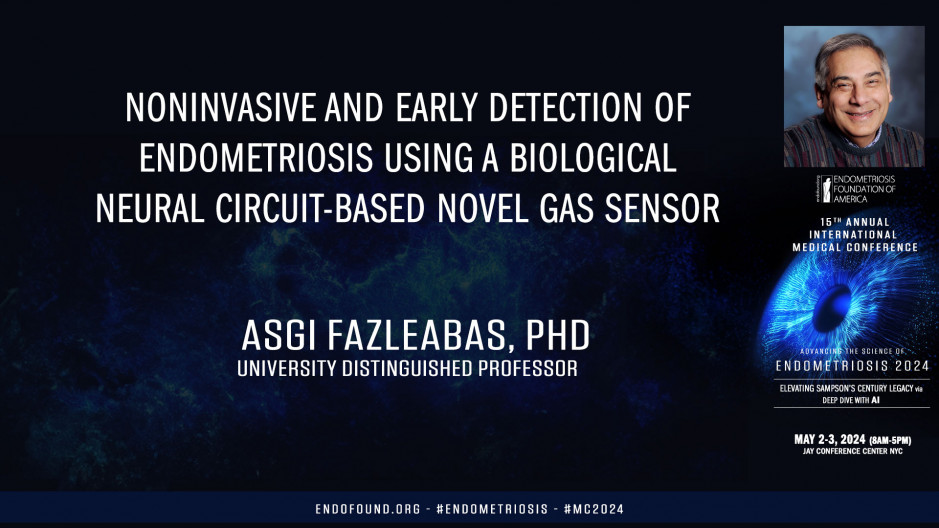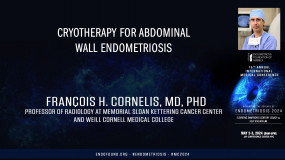International Medical Conference
Endometriosis 2024:
Elevating Sampson’s Century Legacy via
Deep Dive with AI
For the benefit of Endometriosis Foundation of America (EndoFound)
May 2-3, 2024 - JAY CENTER (Paris Room) - NYC
Well, thanks again, Tamer and Dan for inviting me here. It's always an enjoyable visit to be here and see you all friends. And so today I'm going to talk about something totally new. It's very preliminary, just things that we started doing in the lab. And this work has being done in collaboration with de who is a bioengineer and something that came up. He was recruited in Michigan State University and I read one of his papers when he was recruited and he works in cancer. And what I'm going to show you is basically a technique that he developed in terms of using olfactory signals for detecting cancer. And I reached out to him and I said, Hey, how about doing something in endometriosis? And he said, okay, let's do it. This is what we've been doing for the past year or so. Of course, I don't have to tell you that one of the big problems we have is with diagnosing endometriosis is we've heard a lot about nonspecific symptoms, the absence of biomarkers, lack of awareness and symptom normalization that all of these speakers have talked about. And still depending on laparoscopy to the great extent to be able to really identify the disease and be sure with laparoscopy and histology that you've really got the disease.
So we've really been interested in developing some novel tools as we've gone along with regards to thinking about ways to come up with diagnosing this disease. So what we've been focusing on recently are volatile organic compounds. So essentially water and organic compounds are emitted by many parts of your body, predominantly in your breath, other biological fluids like urine and a number of others. So basically the technology. The idea here is that we can analyze these olfactory compounds using technologies and then developing AI and mathematical models to be able to predict that. And in cancer, essentially the analysis of these volatile compounds have really been promising, particularly because these are metabolically active cells and these cells start producing these volatile compounds, so they're easy to detect and they're byproducts of metabolism. So essentially you can identify these compounds to be able to see whether they can be used as markers for disease processes.
So there are a number of different things. You've probably seen dogs every time you go to the airport, and they're very, very sensitive in terms of being able to detect these volatile compounds and other emitters of things that are in people's suitcases and things like that. People have used gas chromatography and mass spec to be able to identify compounds that are found in fluids as well as the electronic nose. Again, using these basic technologies to be able to identify various ence of metabolism that might give you clues as to whether these are products that can be used for analysis. And even to this day, the dog's nose is really probably one of the most sensitive ways of really detecting anything in terms of, you've seen them for ovarian cancer, you've seen them in airports. You've read about them being used extensively in both diseases as well as detection.
So in terms of biological olfaction, the whole idea is to be able to identify compounds at very, very low levels. And what I'm going to show you is using the locus brain, you can measure things at parts per trillion and parts per billion. So very, very low emitting compounds that can be detected readily by using this technology. So we use a locust, and this is again, things that deje developed in his lab. And the locust and the honeybee have very, very sensitive mechanisms through the antenna that can transmit signals to the brain and they can differentiate up to about 40,000 different volatile compounds by simply using the antenna. So basically what happens is that these walkout compounds are first detected by the antenna of the locust and then essentially goes into the olfactory neurons. And these olfactory neurons can transform these electrical chemical stimuli into electrical signals.
And the anterior lobe contains a number of different exci projection neurons. And these neurons can release electrical signals that can then be recorded, and these electrical signals then can be analyzed to be able to give you different clues as to what these compounds are. So the preparation we have here in here is to see whether we can use this methodology that's been used in cancer cells and other studies to see whether we can use this for identifying endometriosis. So this is sort of the experimental setup. I've given you the reference down here that goes into detail exactly how the preparation is done because of the limitation of time, I can't go into a lot of detail, but essentially we use juvenile locus and the juvenile brain is much better at sensing these things than the adult brain is. And the preparation is made, the animal is immobilized, and then the brain is exposed, and these are hooked up with neurons.
So essentially what happens is we grow these cells in a flask. It's a modified T 25 flask and whatever confluence that we need in terms of these cells, essentially we hook these cells up. It's got a little component there, a little needle that's up here, and then another needle that's out here. And this is a seal system. And basically a puff of clean air is put the flask, and then each puff of air then releases a volatile compound into a valve system. And this valve system then releases these compounds in each pulse as you pulse the pulse of clean air. And it goes in here where the antenna is immobilized, where the compound goes in, and then there's an exhaust. So it comes in and goes out very, very, very quickly. And then these compounds are detected by the anterior lobe and the anterior lobe, the neurons of the anterior lobe has these micro electrode arrays with about 18 micro electrodes that then bring about the stimuli.
And these are the electrical signals that you'll see each time there's a puff of this compound that's pushed out from the flask into the system using the system. Preliminary data has strictly been using cell lines, and these are these immobilized cell lines that we have in the lab that we've developed. So these endometrioid epithelial cells, stromal cells, and healthy endometrioid epithelial cells and healthy end endometrial stromal cells. So essentially what happens is by culturing these and doing what I've just shown you, these are the different electrical pulses that you'll find from each individual cell line. So we can check each and every individual cell line in terms of seeing what the electrical circuit and the release is. And then what you find is you do these in multiple experiments. So each puff, so these are representation of five different pulses from each of the cell lines.
You get these signals that come out in an electrical circuit, and then these stimuli can then be normalized and you can develop these grams to show you what these different components are. And the data from multiple experiments can then be coalesced into a single spike that you can then analyze. And then the analysis of this is essentially going back to what we use with bioinformatics is you can use both the principle component and analysis and linear discriminate analysis to be able to separate these out. So as you can see here, these are the different cell lines that I was showing you, the epithelial endometrioid, cell line, endometrioid stromal cells, and utopic, endometrial and stromal cells. And you can see that by computer analysis that each of these different cell lines have a different principle component analysis. So you can separate them out very clearly. And then if you look at the linear discriminant analysis, each of these represents a single experiment or a single puff, and you can see that they all essentially come together in distinct patterns within here, so you know, can discriminate between each and individual cell line using this technology.
And so this tells you that the population neurons that we are seeing, that we can separate out each of the volatile compounds that's released by each different cell and be able to identify these cells individually. And then what you can do is to be able to really put this all together in terms of an analytical component. Oops, go back here to be able to separate out the cell lines and identify them. I'll skip that. It just basically you can use high dimensional analysis and then using a logarithm that does a training and a testing template, you can then separate out each of these individual cell lines by using this mathematical formula. So this way, by comparing these analysis, you can see that each cell line and the control is completely separated out. So the idea here is you use this electronic method and then using logarithms that my colleagues have developed where you can do the three dimensional analysis and then separate out each of these cell lines, you can identify what each cell line represents in terms of this analysis.
So the next question of course, is that anytime you see a lesion, it's a complex lesion. These are individual cells that we've used to identify each individual component that's coming from either epithelial or stromal cells. But of course a lesion has so many different cell types within it. And you've seen a lot of evidence here during the meeting. So the next question we had was, can we do mixtures and be able to separate it out? Because ideally when we're going to take it to a point of using it, can we really be able to separate them out? So the next experiment we did was really start doing ratios of mixing disease cells with healthy cells. And by doing that and doing the same type of analysis that I showed you for the individual cell lines, you can see that as we change the ratios of healthy to disease cells, each of these then develop separate principle component analysis, suggesting that even in a mixed component of cells, you can still separate out unique signatures that are being produced by these cells. And again, you can use the linear discriminate analysis and you can see how nicely each of these mixtures separate. So even in a complex mixture of having cells grounded, these are all in tissue culture dishes, but you can still discriminate based on the ratio of the different types of cells. And the idea here is that if you're going to eventually get to the point where you need to discriminate between disease and no disease, basically that this might be a mechanism that you could use.
And again, using the bin method in terms of using each of the neuron signals and then using a training and a testing template, you can separate out each of these different mixtures. There is some overlap that happens, oops, keep going back. There's some overlap that happens. But for the most part, you can separate out the different ratios of these by using the analysis. So in these very preliminary studies, we've been able to combine neural responses across experiments and be able to get templates that we can classify unknown, volatile organic compounds. And what we can do is once this is done, you can go back to using gas chromatography to be able to separate out these compounds to identify what they are. Right now it's just a mixture of compounds that we've just analyzed using the ability of the brain to develop these electrical signals. But then you can take to the next step and use gas chromatography to be able to really identify which of these compounds, what they are and how we can then use them for analysis.
So this really uses the biological power of the olfactory system. You can do it in locus and honeybees. They're the two best components, best types of insects that you can use to be able to analyze this and hopefully give us a foundation for diagnosing this complex disease. So these have been done in cell lines. So what we are doing right now is using asph. So we've developed a S spheroid system that we published last year in JCI, basically using a combination of stromal and epithelial cells that we can grow and then mimic the peritoneum in a three dimensional method. And so what we're trying to do right now is going back to what I showed you earlier with the mixtures, it's just the epithelial cells, but in this case generates S and asem Lloyds that have a combination of different cell types and see whether we can identify the compounds that are being released by that.
And then also we can use our engineered mouse models then to do some in vivo experiments where we can develop these lesions and begin to see whether we can identify either using urine or my colleagues, again, are developing these cones that they can put over the nose of these animals and get these volatile compounds. So these are things that we are doing now, and it's just really the beginning and hopefully we'll have more data to talk about next time. So these are the people that are doing the work. Simon Sanchez, who's a graduate student in Deit Lab, has really been the graduate student that's been really driving this. And in my lab, Erin and Young have been really pushing this component. So these are the references, they're in the reference file. And thank you again.










